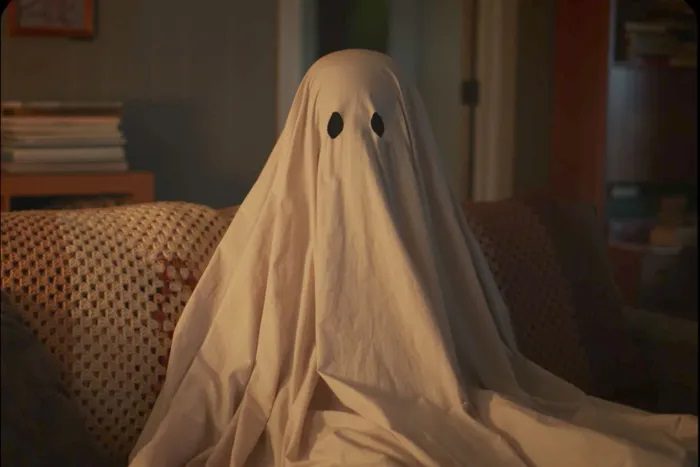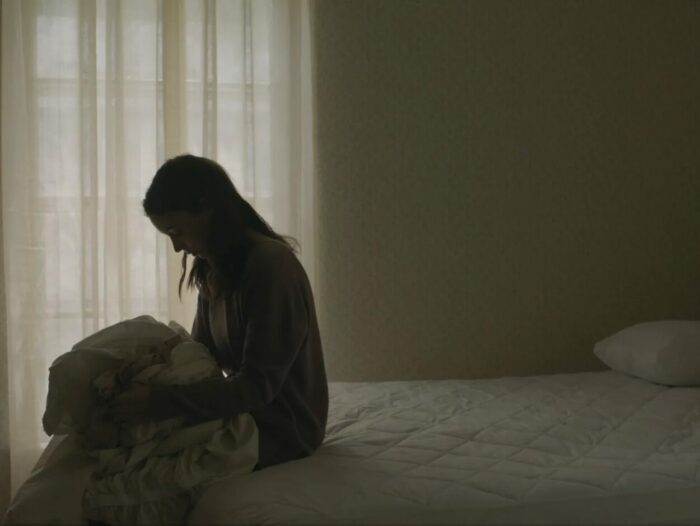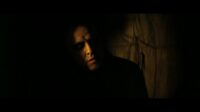It is much too easy to reduce David Lowery’s A Ghost Story to its clever conceit, a gimmick that will work for some and not so much for others. The decision to place a white sheet with cut-out eye holes over Casey Affleck and let him roam around his house is inspired by its simplicity alone. As the rudimentary ghost figure hovers, loiters, dawdles, and lurks like a voyeur, the presence of the paranormal entity creates a tonal paradox, infusing surrealistic absurdity into a film teeming with an overwhelming sense of plaintive loss and melancholy.
The film’s boxy 1.33:1 aspect ratio heightens the cognitive-emotional dissonance, evoking the sentimental friction of clinical remoteness intermixed with nostalgic intimacy. There is something radiantly tender and romantic about A Ghost Story, but it is equally cold and alienating. The film is also an exercise in protracted static shots. Plodding, lugubriously paced, and physically immobile, one often feels as if they’re snooping on someone’s private life: as if sifting through lost Polaroids, suspended in a detached state of longing and wistfulness. These techniques form a viscous, syrupy temporal thickness that clashes with the gossamer-light presence of the lingering entity.
Much of A Ghost Story revolves around the significance and meaning we, as ephemeral beings, derive from the complex equation of time and setting, experience and space, memory and dwelling. Nearly the entire film materializes in a single-family tract home. We witness a young couple, credited as M (Rooney Mara) and C (Casey Affleck), going about their daily routines. C is eager to move to a new home. M, a musician, is less inclined but agrees to. Tragically, he dies in a car crash before they follow through with the plan. In the hospital, M wakes up and walks out wearing a white coroner’s sheet, returning to his home to inhabit the space for what seems to be a loop of eternity.

C’s costuming is the film’s most audacious, inspired, and creatively polarizing aspect. Its startling bareness and minimalism add a comedic undercurrent to the somber, mournful proceedings. There’s a silliness to it, and within this silliness subsists an arch acknowledgment of the metaphorical gravitas of the film. It is unafraid to flaunt its fabricated underpinnings, and in doing so, it lets us look past them more easily, recognizing the spiritual and emotional authenticity lingering behind the billowy, lo-fi ghost sheet.
By maintaining tonal aplomb, Lowery also treats the jocular costuming with straight-faced, sober sincerity. This jarring and irreconcilable defiance of the goofy backdrop allows us to enter the realm of the enchanted on a visceral level. Clearly symbolic, the experiential relationship between the audience and the ghost story intertwines on a deeply resonant semiotic level. One’s expectations of verisimilitude unravel, and in this vacuum, an aboundingly saturnine sense of feeling seeps into the frame, saturating the fantastical setup with timeless notes of existential melancholy and meaning. By announcing its fictive pretenses on the surface, the ideas of the “story” become metafictional and cosmic, both bound to a genuine emotional reality and untethered from the confines of credulity.

Gradually, A Ghost Story’s symbolic logic withdraws not only from spatial-physical reality but spatiotemporal reality as well. For a film so spare in dialogue, the bulk of its thematic weight is somewhat ironically offered in a single, extended monologue spoken by a kitchen-table philosopher (Will Oldham, billed in the credits as Prognosticator) at a party. Touching upon existential themes of impermanence and transience, this Prognosticator waxes poetic about the ultimate futility and finitude of all living things and their creations:
“You can build your dream house… but ultimately, none of that matters any more than digging your fingers into the ground to bury a fence post. Or… or fucking. Which I guess is just about the same thing.”
Filled with nihilistic overtones, this rant mirrors two critical moments in the film: an intimate exchange in bed between M and C and a vignette showing the patriarch of a settler family first placing a stake in the soil at the location of the film’s central home. Its reductive point is simple enough: conflating ecstasy and drudger, an act of construction and an act of coitus, together on a cosmic plane. And from the POV of eternity, this perspective is not altogether wrong. Parallel with the monologue is a third-act sequence where C begins to time travel.
We’ve already witnessed his gloomy, ghoulish self begrudgingly bearing witness to multiple iterations of new tenants after M eventually heals, finds a new love interest, and moves on with her life and out of her home. But in a sudden temporal leap of cinematic bravado, Lowery suddenly places M in a distant, speculative future where the house is bulldozed and replaced by a skyscraper before transporting the ghost back to a distant, speculative past where pilgrims lay stake in the ground before being murdered by ostensible Natives (given the arrows shown protruding from their rotting carcasses). Finally, in the film’s most mind-bending maneuver, Lowery shows C as a ghost, knocking a picture off a piano in the middle of the night and waking up both M and himself (in a scene we’ve already witnessed firsthand in the first act).
Here, Lowery seems to be playing with a Nietzschean-esque notion of eternal recurrence, as C is hypothetically stuck in a temporal loop, reliving past and future moments. This cyclical nature is foreshadowed by the Prognosticator’s bloviating speech, in which he recognizes the infinite loop of contraction and expansion embedded in the physical universe:
“Every atom in this dimension… will be pulled apart by force […] And then all these shredded particles will contract again… and… the universe is gonna suck itself back into a speck too small for any of us to see.” Recapitulating the basic outline of the Big Bang Theory, the Prognosticator extends his astronomical pontifications to reckon with the ontological mootness of aesthetics: ‘Even if some form of mankind carries some recording of Beethoven’s “Ninth Symphony” all the way into the future, the future’s gonna hit a brick wall.’”
Accompanying the speech, Lowery incrementally adds the iconic strings of the “Ninth Symphony,” another keenly accented non-diegetic maneuver (in a way, the ghost costume feels non-diegetic insofar as the characters can’t see it, and therefore, it functions primarily for us, the viewers). The non-diegetic needle drop of the “Ninth Symphony” also reinforces and emphasizes the Prognosticator’s hypothetical “God is dead” analogy wherein Beethoven is envisioned writing the piece (as a pious composer) and confronting a theological crisis:
“Suddenly, he wakes up one day and realizes that God doesn’t exist. So, suddenly, all of these notes and chords and harmonies that were intended to, you know, supersede the flesh, you realize, “Oh, that’s just physics.” So Beethoven says, “Shoot, God doesn’t exist, so I guess I’m writing this for other people. It’s just nuts and bolts now.”
Coupling eternal recurrence and god’s metaphorical death together, Lowery ruefully meditates on the moral arrest and spiritual stagnation that can be triggered by staring into the abyss of cyclical, unending evanescence. These ideas are mirrored by the visual solitude, the glacial pacing, and the quiet, haunting, ambient sound design, which embellish the stark juxtaposition of sentient impermanence with everlasting forlornness. Paralyzed and left in a temporal-spiritual purgatory, C is left to observe life from an omniscient remove, becoming a voyeur of his own trifling sliver of existence, interpolated within the erosive tides and mechanistic indifference of time.
C must watch the world render him senseless and senescent, not only physiologically but in terms of his posterity. He bears witness to M moving through the torrential cycles of grief, emblemized by an infamous one-shot pie-eating scene where Rooney Mara scarfs down the whole dessert in a single sitting. After M finally moves away from their once-shared home, C grows sullen and moody. From one iteration to the next, his presence remains, watching the ebbs and iterations of the space evolve, transform, and regenerate. Somber and lonely, he begins throwing tantrums when a new family moves in, shattering dinner plates in their former kitchen. After this family departs, a younger group moves in, and it is this group that throws the party where the Prognosticator’s monologue is heard by C, lingering in close albeit invisible proximity.
Stoic and silent, C’s unflappable, white-sheet demeanor is difficult, if not impossible, to parse. By the film’s end, I pondered whether he ended up a resigned nihilist afloat in time or lurked with an affirmative stance. This ambiguity brought to mind Nietzsche’s notion of eternal recurrence. This theory reappears throughout his works but is most prominently cited as materializing in the cryptic parable section 341 of The Gay Science:
What if some day or night a demon were to steal after you into your loneliest loneliness and say to you, “This life as you now live it and have lived it, you will have to live once more and innumerable times more, and there will be nothing new in it, but every pain and every joy and every thought and sigh and everything unutterably small or great in your life will have to return to you, all in the same succession and sequence […] Would you not throw yourself down and gnash your teeth and curse the demon who spoke thus? Or have you once experienced a tremendous moment when you would have answered him: “You are a god, and never have I heard anything more divine.”
When placed in the context of Nietzsche’s infamous nihilism, the last line’s nod to a godlike entity is breathtakingly mysterious and figuratively loaded. In anointing a deity to experience itself (attributing a divine power to life’s recursive mundaneness and successive triviality), Nietzsche is seemingly pointing to the existential dilemma of eternal recurrence as a test that measures one’s ability to regain faith and affirmation in the fleeting, free-floating, quotidian phenomena of everyday existence. This spiritual quandary mirrors the simmering, low-key dread one vicariously feels while imagining the ostracized frame of mind C must endure.
Like C, we are severed from the action, ostensibly left to wander the remote recesses of our subconscious fears. I began pondering the meaning of evergreen happenings in the absence of selfhood, autonomy, and agency. Are memories enough to sustain an identity? What is the function of remembrance and recurrence in a solipsistic vacuum?
The fact that C is an artist (a musician) is integral to the story as it allows his physical demise and spiritual residue to question whether yearning for creative posterity is itself a vain human project. Metaphorically tinkering once again with the sound design, Lowery offers a glimpse into how art can transcend a life while challenging its oft-exaggerated lasting power. He achieves this by contrasting the timbres of Dark Rooms’ “I Get Overwhelmed” (a song C wrote) as it is listened to in two distinct moments: when M first hears the song with headphones after its initial conception and when she posthumously plays it again through earbuds while lying on the floor. Each version’s sonic textures are remarkably different despite being edited, elided, and spliced together. The initial listen is full-bodied, robust, pulsing with corpulence; the eulogistic listen echoes, tinny and fading with dirge-like somnolence.
Here, we see C’s artistic output as something with a longer shelf life than his personal existence, but a limited one nonetheless. This reinforces why he might be stuck in ontological limbo. If there is a recognizable fissure in the foundations of M and C’s relationship, it is their respective and differing ascriptions of meaning to place. In a quietly tense argument, the two debate the merits of moving from their home. Wanting to move to the city, M asks what C loves about their humble little home so much. His answer is direct: “History.” This offers a keen insight into his motive in making music: marking time, meaning, and emotion into something with a sense of history.
M, meanwhile, is not immune to this instinct. The film is bookmarked with the loaded symbolism of the notes she leaves behind. In the film’s opening scene, the two lie in bed as M recalls the rootlessness of her childhood and her unique way of dealing with the unmoored mutability of that phase in her life: “When I was little, and we used to move all the time, I’d write these notes, and I would fold them up really small. And I would hide them.” C, of course, is curious about what the notes said, but the content itself is less relevant than the solace of leaving remains: “They’re just things I wanted to remember so that if I ever wanted to go back, there’d be a piece of me there waiting.”
Quite beautifully, A Ghost Story ends with C retrieving one of these notes from the walls of the home he’s haunting. Alas, he holds onto a parchment that contains a piece of M, the woman he loved, and the history with which his identity was entangled. Like Beethoven’s post-god impetus, art here operates as a localized, interpersonal vessel created for the people one lived among and with. However, unlike the cynical Beethoven analogy, art is not reduced to mere deterministic “nuts and bolts.” It seems to carry an extra dimension: the power of meaning, which may crumble and recrudesce periodically (being bulldozed, razed, and re-erected like a home), but which always harbors a specificity and a permanence within the eternal circulation of cosmic occurrences’.
Ideas of art and meaning enduring forever may be a quixotic fancy, but that doesn’t mean they won’t always exist, having once transpired. This is the leap of faith in embracing eternal recurrence despite the disappearance of an all-engulfing telos or deity. This is the eschatology of reclaiming the infinitesimal moments in a reverberating infinity.


